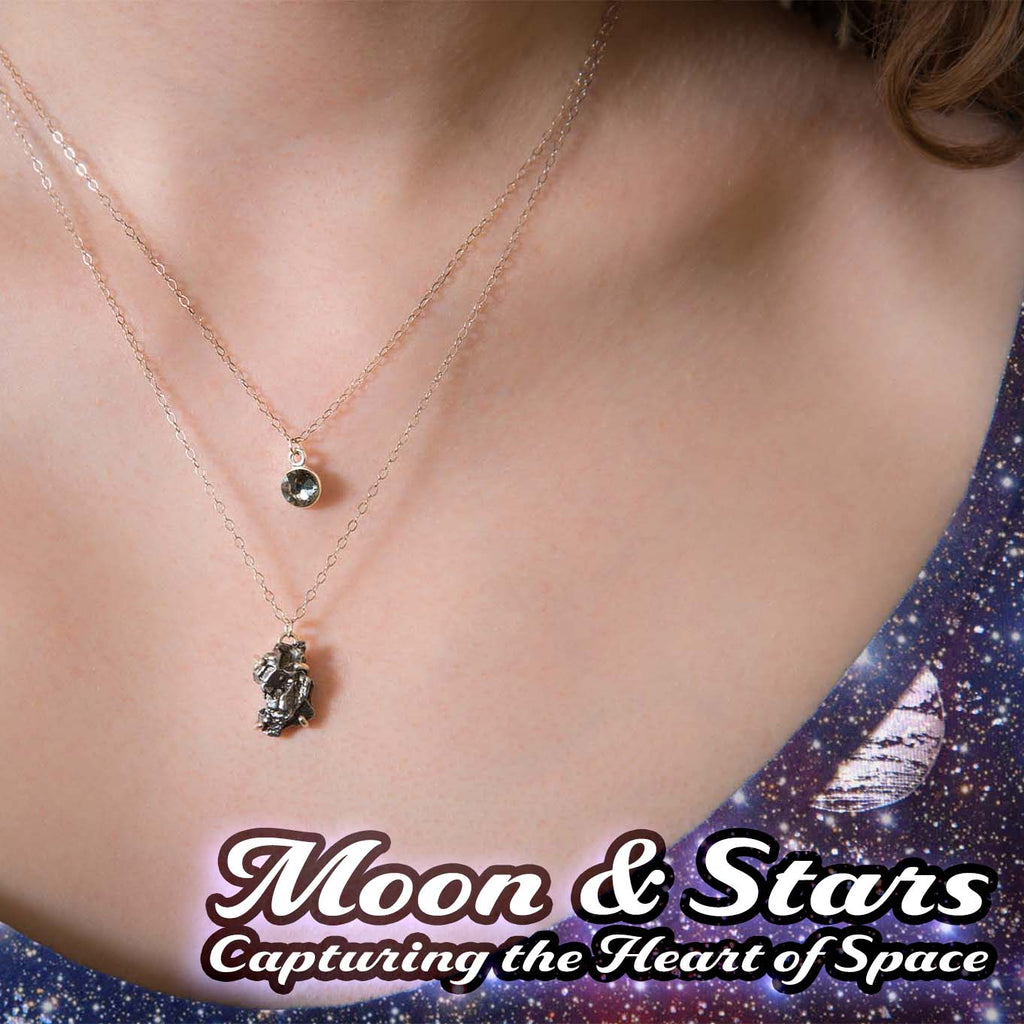Moon & Stars Necklace





Moon & Stars Necklace





















A Pairing of Meteorites Billions of Years in the Making
The Moon & Stars necklace pairs lunar dust from the bright highlands of the moon with a dense asteroid formed during the birth of the solar system.
Share the beauty of space and time with someone you love!




📸 Moon & Stars Necklace
A Mini Museum Original!
Moon & Stars pairs lunar dust from the bright highlands of the moon with a dense asteroid forged during the birth of our solar system. Handcrafted here at Mini Museum, this two strand, sterling silver necklace features two specimens: a complete Campo del Cielo meteorite and a Swarovski crystal backed with lunar dust from meteorite NWA 5000.

As pictured, both chains are cable-style Sterling Silver. The chains connect by means of a spring clasp. Each setting is also Sterling Silver:
16-18": The top chain measures 16 inches (~40cm) and the bottom chain measures 18 inches (~46cm).
18-20": The top chain measures 18 inches (~46cm) and the bottom chain measures 20 inches (~51cm).
The necklace comes in a decorative box and includes a small information card about the specimens. The card serves as the certificate of authenticity and can be found underneath the padded lining of the display box.

📸 Campo del Cielo in setting prior to securing with Swarovski crystals
Handcrafting Moon & Stars
From the endless beauty of outer space to the mysteries of deep time, the Mini Museum Jewelry Collection is a new way to share your love of science, history, and the universe.
Our team works very hard to prepare these authentic meteorite specimens. The result is a unique piece of jewelry for each and every person!


"[Standing on the Moon] You develop an instant global consciousness, a people orientation, an intense dissatisfaction with the state of the world, and a compulsion to do something about it." ~ Edgar D. Mitchell, Apollo 14 Astronaut

📸 Meteorite NWA 5000 (Image Credit: Gregory M. Hupé)
Discovered in Morocco in 2007, the NWA 5000 meteorite is one of the largest lunar meteorites. Its composition suggests a highlands origin. The highlands of the moon are the white areas we can see with the naked eye here on Earth. These regions are dominated by a range of intrusive igneous rocks, such as the gabbro of NWA 5000.
Known in geology as anorthosites, these rocks form when large plumes of magma cool and crystallize within the crust. The darker areas of the moon, known as "seas" due to their visual appearance, are basalts created during volcanic floods on the surface.

Campo del Cielo is often referred to as a single meteorite but it is in fact a broad term defining a meteorite field in the Chaco Province of Northwest Argentina. There are numerous large craters here and radiocarbon dating of charred tree stumps place the date of the impact at roughly 2500 BCE. The tale of the original fall was passed down from generation to generation and woven into local legends.
The region, known as Piguem Nonraltá, became a place of pilgrimage, worship, and industry. The indigenous Quechuan name translates to Spanish as Campo del Cielo or "Field of Heaven." The name was recorded in 1576 CE by the Governor of the provinces of Tucumán, Gonzalo de Abreu y Figueroa, as the Spanish searched for the source of iron being used in indigenous weapons and possible silver deposits.
More recent studies have shown that Campo del Cielo is an IAB iron meteorite. As with other meteorites in this class, radioisotopic dating of silicate inclusions places the age of the main mass at roughly 4,400,000-4,500,000 years old.

📸 Artist's concept of the Piguem Nonraltá (Source: Mini Museum)
Further Reading
Riccioli, Giovanni Battista. "Almagestum novum", Bologna, 1651.
Grange, M. L., M. D. Norman, and V. Assis Fernandes. "Clues to the Origin of Gabbroic Lunar Meteorite Northwest Africa 5000." Lunar and Planetary Science Conference. Vol. 47. 2016.
Wood, Charles Arthur, and Maurice JS Collins. 21st century atlas of the Moon. West Virginia University Press, 2013.
Hidaka, Hiroshi, et al. "Isotopic Evidence for Multi-stage Cosmic-ray Exposure Histories of Lunar Meteorites: Long Residence on the Moon and Short Transition to the Earth." The Astronomical Journal 153.6 (2017): 274.
Barrientos, G., Masse, W.B. “The Archaeology of Cosmic Impact: Lessons from Two Mid-Holocene Argentine Case Studies.” J Archaeol Method Theory, vol. 21, 2014, pp. 134–211.
Métraux, Alfred, 1902-1963. Myths of the Toba And Pilagá Indians of the Gran Chaco. Philadelphia: American Folklore Society, 1946.
Cassidy, W. A., Renard, M. L. “Discovering research value in the Campo del Cielo, Argentina, meteorite craters.” Meteoritics & Planetary Science, vol. 31, no. 4, 1996, pp. 433-448.
Vogel, N., and P. R. Renne. "Constraining the Formation and Evolution of IAB Irons---High Precision 40Ar/39Ar Ages on Plagioclase Separates from Silicate Inclusions of the Campo Del Cielo Meteorite." Lunar and Planetary Science Conference. Vol. 35. 2004.














